Tefillin
Tefillin (Askhenazic: /ˈtfɪlɪn/; Israeli Hebrew: [tfiˈlin], תְּפִלִּין or תְּפִילִּין) or phylacteries, is a set of small black leather boxes containing scrolls of parchment inscribed with verses from the Torah. Tefillin is worn by observant adult Jews during weekday morning prayers. In Orthodox communities, it is only worn by men, while in non-Orthodox communities, it may be worn by men and women.
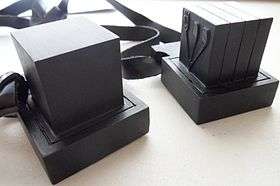 A set of tefillin includes the arm-tefillah (left) and the head-tefillah | |
| Halakhic texts relating to this article | |
|---|---|
| Torah: | |
| Mishnah: | Menachot 3:7 |
| Babylonian Talmud: |
|
| Mishneh Torah: | Tefillin, Mezuzah, veSefer Torah ch 5-6 |
| Shulchan Aruch: | Orach Chayim 25-48 |
Although "tefillin" is technically the plural form (the singular being "tefillah"), it is often used as a singular as well.[1] The arm-tefillah (or shel yad) is placed on the upper arm, and the strap wrapped around the arm, hand and fingers; while the head-tefillah (or shel rosh) is placed above the forehead. It is intended to fulfill the Torah's instructions to keep as a "sign" and "remembrance" of the Exodus, signifying that God brought the children of Israel out of Ancient Egypt.
The biblical verses often cited as referring to tefillin are obscure. Deuteronomy 11:18, for instance, does not designate explicitly what specifically to "bind upon your arm", and the definition of "totafot between your eyes" is not obvious. At least as early as the 1st century CE, many Jews understood the verses literally and wore physical tefillin, as shown by archaeological finds at Qumran[2] and a reference in the New Testament. However, Karaite Judaism understands the verses to be metaphorical.
Biblical source
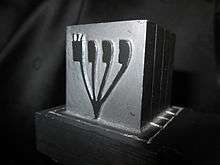
The obligation of tefillin is mentioned four times in the Torah:
twice when recalling The Exodus from Egypt:
And it shall be for a sign for you upon your hand, and for a memorial between your eyes, that the law of the LORD may be in your mouth; for with a strong hand did the LORD bring you out of Egypt.
— Exodus 13:9
And it shall be for a sign upon your hand, and as totafot between your eyes; for with a mighty hand did the LORD bring us forth out of Egypt.
— Exodus 13:16
and twice in the shema passages:
And you shall bind them as a sign upon your arm, and they shall be as totafot between your eyes.
— Deuteronomy 6:8
You shall put these words of mine on your heart and on your soul; and you shall tie them for a sign upon your arm, and they shall be as totafot between your eyes.
— Deuteronomy 11:18
Etymology
The ultimate origin of Hebrew "tefillin" is uncertain.[3] The word "tefillin" is not found in the Bible, which calls them ot (sign), zikaron (memorial), or ṭoṭafot. The Septuagint renders "ṭoṭafot" ἀσάλευτον asauleton, "something immovable".[4][5] Some believe it refers to a charm, similar to the Hebrew neṭifot, "round jewel".[4] The Talmud[6] explains that the word ṭoṭafot is combination of two foreign words: Tot means "two" in the "Caspi" language and Fot means "two" in the "Afriki" language,[7] hence, tot and fot means "two and two", corresponding to the four compartments of the head-tefillin.[8] Menahem ben Saruq explains that the word is derived from the Hebrew Ve'hateif and Tatifoo, both expressions meaning "speech", "for when one sees the tefillin it causes him to remember and speak about the Exodus from Egypt".[9]
The first texts to use "tefillin" are the Targumim and Peshitta[4] and it is also used in subsequent Talmudic literature, although the word "ṭoṭafah" was still current, being used with the meaning of "frontlet".[4] "Tefillin" may have derived from the Aramaic palal, "to plead, pray", a word closely related to the Hebrew tefillah, "prayer".[3] Jacob ben Asher (14th century) suggests that "tefillin" is derived from the Hebrew pelilah, "justice, evidence", for tefillin act as a sign and proof of God's presence among the Jewish people.[10]
The English word "phylactery" ("phylacteries" in the plural) derives from Ancient Greek φυλακτήριον phylaktērion (φυλακτήρια phylaktēria in the plural), meaning "guarded post, safeguard, security", and in later Greek, "amulet" or "charm".[11][12] The word "phylactery" occurs once (in ACC PL) in the Greek New Testament,[13] whence it has passed into the languages of Europe.[4] Neither Aquila nor Symmachus use "phylacteries" in their translations.[4] The choice of this particular Greek equivalent to render the Heb. tefillin bears witness to the ancient functional interpretation of the said device as a kind of an amulet. The other Greek words for "amulet" are periapton or periamma,[14] which literally signifies "things tied around", analogously to the Hebrew qame‘a derived from the root קמע meaning "to bind".[15]
Purpose
The tefillin are to serve as a reminder of God's intervention at the time of the Exodus from Egypt.[16] Maimonides details of the sanctity of tefillin and writes that "as long as the tefillin are on the head and on the arm of a man, he is modest and God-fearing and will not be attracted by hilarity or idle talk; he will have no evil thoughts, but will devote all his thoughts to truth and righteousness".[17] The Sefer ha-Chinuch (14th century) adds that the purpose of tefillin is to help subjugate a person's worldly desires and encourage spiritual development.[18] Joseph Caro (16th century) explains that tefillin are placed on the arm adjacent to the heart and on the head above the brain to demonstrate that these two major organs are willing to perform the service of God.[19]
Many have the custom to have high-quality tefillin and beautiful tefillin bags as a Hiddur Mitzvah. This idea comes from the verse "This is my God and I will glorify Him" (Exodus 15:2). The Jewish Sages explain: "Is it possible for a human being to add glory to his Creator? What this really means is: I shall glorify Him in the way I perform mitzvot. I shall prepare before Him a beautiful lulav, beautiful sukkah, beautiful fringes (Tsitsit), and beautiful phylacteries (Tefilin)."[20][21][22]
Some non-Orthodox scholars think that tefillin may play an apotropaic function. For instance, Yehudah B. Cohn argues that the tefillin should be perceived as an invented tradition aimed at counteracting the popularity of the Greek amulets with an "original" Jewish one.[23] Joshua Trachtenberg considered every ornament worn on the body (whatever its declared function) as initially serving the purpose of an amulet.[24] In addition, the early Rabbinic sources furnish more or less explicit examples of the apotropaic qualities of tefillin. For instance, Numbers Rabbah 12:3 presents tefillin as capable of defeating "a thousand demons" emerging on "the left side", rabbis Yohanan and Nahman used their sets to repel the demons inhabiting privies,[25] whereas Elisha the Winged, who was scrupulous in performing this mitzvah, was miraculously saved from the Roman persecution.[26][27] Also, tefillin are believed to possess life-lengthening qualities,[28] and they are often listed in one breath among various items which are considered amuletic in nature.[29][30]
Manufacture and contents
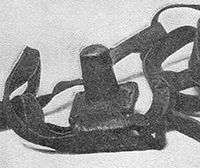
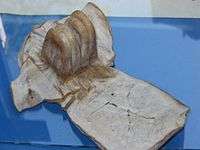
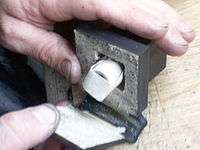
The manufacturing processes of tefillin are intricate and governed by hundreds of detailed rules.[32]
Boxes
In earlier Talmudic times, tefillin were either cylindrical or cubical, but later the cylindrical form became obsolete.[33] Nowadays the boxes should be fashioned from a single piece of animal hide and form a base with an upper compartment to contain the parchment scrolls.[34] They are made in varying levels of quality. The most basic form, called peshutim ("simple"), are made using several pieces of parchment to form the inner walls of the head tefillin. The higher quality tefillin, namely dakkot ("thin"), made by stretching a thin piece of leather, and the more durable gassot ("thick") are both fashioned from the single piece of hide.[35]
The main box which holds the tefillin scrolls, known as ketitzah (קציצה), is cubical. Below it is a wider base known as the titura (תיתורא). At the back of the titura is a passageway (ma'avarta, מעברתא) through which the tefillin strap is threaded, to tie the tefillin in place.
On both sides of the head-tefillin, the Hebrew letter shin (ש) is moulded; the shin on the wearer's left side has four branches instead of three.
Straps
Black leather straps (retsu'ot) pass through the rear of the base and are used to secure the tefillin onto the body.[4] The knot of the head-tefillin strap forms the letter dalet (ד) or double dalet (known as the square-knot) while the strap that is passed through the arm-tefillin is formed into a knot in the shape of the letter yud (י). Together with the shin on the head-tefillin box, these three letters spell Shaddai (שדי), one of the names of God.[4]
The straps must be black on their outer side, but may be any color except red on their inner side.[36] A stringent opinion requires them to be black on the inner side too,[37] but more commonly the inner side is left the color of leather.
The Talmud specifies that tefillin straps must be long enough to reach one's middle finger, and records the practice of Rav Aha bar Jacob to tie and then "matleit" (plait? wind three times?) them.[38] However, the passage leaves unclear where the measuring is done from, whether the reference is to hand- or head-tefillin, and what exactly the meaning of "matleit" is. Combining and interpreting the Talmud's statements, Maimonides, Tur, and Shulchan Aruch ruled that the strap of hand-tefillin must reach from where the tefillin is placed on the arm, as far as the middle finger, where it must be wound three times around the middle finger.[39] Rema wrote that it is not necessary to wind around the finger (rather, the straps must be long enough that one could wind around the finger);[40] however, this leniency does not appear in his comments to the Shulchan Aruch. In addition to the windings around the finger, the Shulchan Aruch states that the custom is to wind six or seven times around the forearm.[41]
Parchment scrolls
The four biblical passages which refer to the tefillin, mentioned above, are written on scrolls and placed inside the leather boxes.[4] The arm-tefillin has one large compartment, which contains all four biblical passages written upon a single strip of parchment; the head-tefillin has four separate compartments in each of which one scroll of parchment is placed.[4][42] This is because the verses describe the hand-tefillin in the singular ("sign"), while in three of four verses, the head-tefillin is described in the plural ("totafot").
The passages are written by a scribe with special ink on parchment scrolls (klaf).[4] These are: "Sanctify to me ..." (Exodus 13:1–10); "When YHWH brings you ..." (Exodus 13:11–16); "Hear, O Israel ..." (Deuteronomy 6:4–9); and "If you observe My Commandments ..." (Deuteronomy 11:13-21).[4] The Hebrew Ashuri script must be used and there are three main styles of lettering used: Beis Yosef – generally used by Ashkenazim; Arizal – generally used by Hasidim; Velish – used by Sefardim.[43] The passages contain 3,188 letters, which take a sofer (scribe) between 10–15 hours to complete.[44]
The texts have to be written with halachically acceptable (acceptable according to Jewish law) ink on halachically acceptable parchment. There are precise rules for writing the texts and any error invalidates it. For example, the letters of the text must be written in order - if a mistake is found later, it can't be corrected as the replacement letter would have been written out of sequence. There are 3188 letters on the parchments, and it can take a scribe as long as 15 hours to write a complete set. The scribe is required to purify himself in the mikvah (ritual bath) before he starts work.
Ordering of scrolls (Rashi and Rabbeinu Tam tefillin)
Talmudic commentators debated the order in which scrolls should be inserted into the four compartments of the head-tefillin.[4] Rashi held that the passages are placed according to the chronological order as they appear in the Torah (Kadesh Li, Ve-haya Ki Yeviehcha, Shema, Ve-haya Im Shemoa), while according to Rabbeinu Tam, the last two passages are switched around.[45] Of the tefillin dating from the 1st-century CE discovered at Qumran in the Judean Desert, some were made according to the order understood by Rashi and others in the order of Rabbeinu Tam.[45]
Nowadays, the prevailing custom is to arrange the scrolls according to Rashi's view, but some pious Jews are also accustomed to briefly lay the tefillin of Rabbeinu Tam as well,[45] a custom of the Ari adopted by the Hasidim.[46] The Vilna Gaon, who wore the tefillin of Rashi, rejected the stringency of also laying Rabbeinu Tam, pointing out that there were 64 possible arrangements of the tefillin scrolls, and it would not be practical to put on 64 different sets of tefillin to account for all possibilities.[47] The Shulchan Aruch rules that only "one who is known and famous for his piety" should put on Rabbeinu Tam tefillin,[48] while the Mishnah Brurah explains that if any other person puts on Rabbeinu Tam tefillin, it is a sign of arrogance.[49]
The placement of the protrusion of a tuft of the sinew (se'ar eigel) identifies as to which opinion the tefillin were written.[50]
Obligation and gender
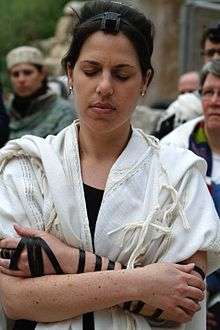
The duty of laying tefillin rests upon Jews after the age of thirteen years.[4] Although women were traditionally exempt from the obligation, some early codifiers allowed them to do so.[51] Rema (Rav Moses Isserles, 16th century), a major codifier of the Jewish law, strongly discourages it.[52]
Historically, the mitzvah of tefillin was not performed by women, but the ritual was apparently kept by some women in medieval France and Germany.[53] It has been claimed Rashi's daughters and the wife of Chaim ibn Attar wore tefillin,[54] but there is no historical evidence for these claims.[55] However, the female Hasidic Rebbe known as Maiden of Ludmir did wear tefillin.[55]
In modern times, people of both genders choose to wear tefillin, and are encouraged to do so by some.[56] In 2018, a group of students from Hebrew College, a non-denominational rabbinical school in Boston, created a series of YouTube videos to help people of both genders learn how to wrap tefillin.[57] Within the Orthodox movement, it remains a male-only obligation, but in egalitarian movements, women may observe this practice. Women affiliated with the Conservative movement wrap tefillin.[58] Since 2013, SAR High School in Riverdale, New York, has allowed girls to wrap tefillin during morning prayer; it is probably the first Modern Orthodox high school in the U.S. to do so.[59] The wearing of tefillin by members of Women of the Wall at the Western Wall caused consternation from the rabbi in charge of the site until a Jerusalem District Court judge ruled in 2013 that doing so was not a violation of "local custom".[60]
A mourner during the first day of his mourning period is exempt from wrapping tefillin as is a bridegroom on his wedding-day.[4] A sufferer from stomach-trouble or one who is otherwise in pain and cannot concentrate his mind is also exempt.[4] One who is engaged in the study of the Law and scribes of and dealers in tefillin and mezuzahs while engaged in their work if it cannot be postponed, are also free from this obligation.[4]
The codes view the commandment of tefillin as important, and call those who neglect to observe it "transgressors".[61] Maimonides counts the commandment of laying the arm-tefillin and head-tefillin as two separate positive mitzvot.[17] The Talmud cites Rav Sheshet, who said that by neglecting the precept, one transgresses eight positive commandments.[62] A report of widespread laxity in its observance is reported by Moses of Coucy in 13th-century Spain. It may have arisen from the fear of persecution, similar to what had occurred to the Jews living in the Land of Israel under Roman rule in the second century.[16]
Use
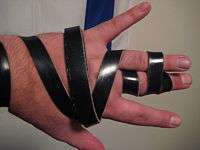
Originally tefillin were worn all day, but not during the night. Nowadays the prevailing custom is to wear them only during the weekday morning service,[63] although some individuals wear them at other times during the day as well.
Tefillin are not donned on Shabbat and the major festivals because these holy days are themselves considered "signs" which render the need of the "sign" of tefillin superfluous.
On the fast day of Tisha B'Av, tefillin are not worn in the morning, as tefillin are considered an "adornment", symbols of beauty, which is deemed inappropriate for a day of mourning. They are worn instead at the afternoon Mincha service.[64] There are those however who have a custom (Jews from Aleppo, Syria) on Tisha B'Av to privately put on tefillin at home and pray privately, say the Amidah and take off the tefillin and go to synagogue to finish the prayers.
Chol HaMoed
On Chol HaMoed (intermediate days) of Pesach and Sukkot, there is a great debate among the early halachic authorities as to whether tefillin should be worn or not. Those who forbid it consider the "sign" of intermediate days as having the same status as the festival itself, making the ritual of tefillin redundant.[65] Others argue and hold that Chol HaMoed does not constitute a "sign" in which case tefillin must be laid.[65] Three customs evolved resulting from the dispute:
- To refrain from wearing tefillin: This ruling of the Shulchan Aruch is based on kabbalah and the Zohar which strongly advocate refraining from laying tefillin on Chol HaMoed. This position is maintained by Sephardic Jews and is also the opinion of the Vilna Gaon whose ruling has been universally accepted in Israel.[65]
- To wear tefillin without reciting the blessings: This is the opinion of, among others, Rabbi Jacob ben Asher (Ba'al ha-Turim), Rabbi Moses of Coucy (Semag) and Rabbi David HaLevi Segal (Turei Zahav). The advantage of this compromise is that one avoids the transgressions of either not donning tefillin or making a blessing in vain.[65]
- To wear tefillin and recite the blessings in an undertone: This opinion, based on Maimonides, is the ruling of Moses Isserles who writes that this is the universally accepted practice among Ashkenazic Jews.[65] However it may have been in his time, this is no longer universally the case, since many Ashkenazim refrain from wearing it or wear it without a blessing during Chol HaMoed.
In light of the conflicting opinions, the Mishna Berura (20th-century) recommends Ashkenazim make the following stipulation before donning tefillin: "If I am obligated to don tefillin I intend to fulfill my obligation and if I am not obligated to don tefillin, my doing so should not be considered as fulfilling any obligation" and that the blessing not be recited.[66]
Laws and customs regarding putting on tefillin

Ashkenazi practice is to put on and remove the arm tefillin while standing in accordance to the Shulchan Aruch, while most Sephardim do so while sitting in accordance with the Ari. All, however, put on and remove the head tefillin while standing.[67] Halacha forbids speaking or being distracted while putting on the tefillin.[67] An Ashkenazi says two blessings when laying tefillin, the first before he ties the arm-tefillin: ...lehani'ach tefillin ("to bind tefillin"), and the second after placing the head tefillin: ...al mitzvat tefillin ("as to the commandment of tefillin"); thereafter, he tightens the head straps and says "Baruch Shem Kovod..." ("blessed be the holy name").[68] The Sephardic custom is that no blessing is said for the head-tefillin, the first blessing sufficing for both.[68] Sephardim and many members of the Chabad Orthodox movement only recite the blessing on the head-tefillah if they spoke about something not related to tefillin since reciting the blessing on the arm-tefillah.
The arm-tefillin is laid on the inner side of the bare left arm, right arm if one is left handed, two finger breadths above the elbow, so that when the arm is bent the tefillin faces towards the heart.[4] The arm-tefillin is tightened with the thumb, the blessing is said, and the strap is immediately wrapped around the upper arm in the opposite direction it came from in order to keep the knot tight without having to hold it. Some wrap it around the upper arm for less than a full revolution (the bare minimum to keep the knot tight) and then wrap it around the forearm seven times, while others wrap it around the upper arm an additional time before wrapping it around the forearm. Many Ashkenazim wear the knot to be tightened (not to be confused with the knot on the base which is permanently tied and always worn on the inside, facing the heart) on the inside and wrap inward, while Nusach Sephard Ashkenazim and all Sephardim wear it on the outside and wrap outward.[4]
Then the head-tefillin is placed on the middle of the head just above the forehead, so that no part rests below the hairline. A bald or partially bald person's original hairline is used.[69] The knot of the head-tefillin sits at the back of the head, upon the part of the occipital bone that protrudes just above the nape. The two straps of the head-tefillin are brought in front of the shoulders, with their blackened side facing outwards.[4] Now the remainder of the arm-tefillin straps are wound three times around the middle finger and around the hand to form the shape of the Hebrew letter of either a shin (ש) according to Ashkenazim, or a dalet (ד) according to Sephardim. There are various customs regarding winding the strap on the arm and hand.[68] In fact, the arm strap is looped for counter-clockwise wrapping with Ashkenazi tefillin while it is knotted for clockwise wrapping with Sephardic and Hasidic tefillin. On removing the tefillin, the steps are reversed.[4]
Earlier, Yemenite Jews' custom was to put on arm-Tefillah and wind forearm with strap, making knot on wrist not winding a finger, and then put on head-Tefillah all made in sitting position. Later, Yemenite Jews followed by Shulchan Aruch and put on arm-Tefillah, making seven windings on forearm and three on a finger, and then put on head-Tefillah. Because according to the Shulchan Aruch head-Tefillah and arm-Tefillah are two different commandments, if there is not any Tefillah, one can wear available alone.[70]
German Jews also did not tie a finger earlier. But later they put on arm-Tefillah with a knot on biceps while standing, then put on head-Tefillah, and after that they wind seven wraps around forearm (counting by the seven Hebrew words of Psalms 145:16), and three wraps around a finger.
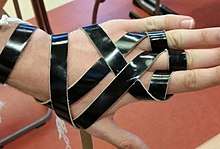
The newest is Kabbalistic custom of Arizal, to put on arm-Tefillah and wind seven wraps on forearm while sitting, then head-Tefillah standing, after that three wraps around a finger. That is modern day common custom.
Some Western Sephardic families such as the Rodrigues-Pereira family have developed a personalized family wrapping method.[71]
Biblical commandments
| Location | Passage |
|---|---|
| Exodus 13:1–10: Kadesh Li— the duty of the Jewish people to remember the redemption from Egyptian bondage. |
And the LORD spoke to Moses, saying: 'Sanctify to Me all the first-born, whatever opens the womb among the children of Israel, both of man and of animal, it is Mine.' And Moses said to the people: 'Remember this day, in which you came out from Egypt, out of the house of bondage; for by strength of hand the LORD brought you out from this place; no leavened bread shall be eaten. This day you go forth in the Spring month. And it shall be when the LORD shall bring you into the land of the Canaanite, and the Hittite, and the Amorite, and the Hivite, and the Jebusite, which He swore unto your fathers to give you, a land flowing with milk and honey, that you shall keep this service in this month. Seven days you shall eat unleavened bread, and the seventh day shall be a feast to the LORD. Unleavened bread shall be eaten throughout the seven days; and no leavened bread shall be seen with you, neither shall there be leaven seen with you, in all your borders. And so shall you tell your son on that day, saying: It is because of that which the LORD did for me when I came forth out of Egypt. And it shall be for a sign for you upon your hand, and as a memorial between your eyes, that the law of the LORD may be in your mouth; for with a strong hand has the LORD brought you out of Egypt. You shalt therefore keep this ordinance in its season from year to year. |
| Exodus 13:11–16: Ve-haya Ki Yeviakha— the obligation of every Jew to inform his or her children on these matters. |
When the LORD brings you into the land of the Canaanite, as He swore unto you and to your fathers, and shall give it to you, you shall set apart to the LORD all that opens the womb; every firstborn animal shall be the LORD'S. Every firstborn donkey you shall redeem with a sheep, and if you will not redeem it, then you shall break its neck; and all the first-born of man among your sons shall you redeem. And when your son asks you in time to come, saying: What is this? say to him: By strength of hand the LORD bring us out from Egypt, from the house of bondage; and when Pharaoh found it hard to let us go the LORD killed all the firstborn in the land of Egypt, both the first-born of man, and the first-born of animals; therefore I sacrifice to the LORD all males that open the womb, and redeem all my first-born sons. And it shall be for a sign upon your hand, and as "totafot" between your eyes; for by strength of hand the LORD brought us forth out of Egypt. |
| Deuteronomy 6:4–9: Shema— pronouncing the Unity of the One God. |
Hear, O Israel: the LORD our God, the LORD is one. And you shall love the LORD your God with all your heart, and with all your soul, and with all your might. And these words, which I command you this day, shall be upon your heart; and teach them thoroughly to your children, and speak of them when you sit in your house, and when you walk on the road, and when you lie down, and when you get up. And tie them for a sign upon your hand, and let them be "totafot" between your eyes. And write them on the door-posts of your house and on your gates. |
| Deuteronomy 11:13–21: Ve-haya Im Shamoa— God's assurance of reward for observance of the Torah's precepts and warning of retribution for disobedience. |
If you listen to My commandments which I command you today, to love the LORD your God, and to serve Him with all your heart and with all your soul, then I will give the rain of your land in its season, the early and the late rain, and you will gather in your grain, your wine, and your oil. And I will give grass in your fields for your cattle, and you will eat and be satisfied. Take care for yourselves, lest your heart be seduced, and you turn aside, and serve other gods, and worship them; and the anger of the LORD be lit against you, and He shut up the heaven, so that there shall be no rain, and the ground not yield her fruit; and you be quickly lost from off the good land which the LORD gives you. Put these words of Mine on your heart and on your soul; tie them as a sign on your hand, and they shall be "totafot" between your eyes. Teach them to your children, to speak of them when you sit in your house, and when you walk on the road, and when you lie down, and when you rise up. And write them on the door-posts of your house, and upon your gates; so that your days, and those of your children, may be multiplied upon the land which the LORD swore unto your fathers to give them, as the days of the heavens above the earth. |
Health
A 2018 study, performed on 20 Jewish men around Cincinnati, suggested that tight wrapping of the arm-tefillin could have a positive effect regarding heart-disease.[72][73]
See also
- Ktav Stam
- Tefillin Campaign
References
- Steinmetz, Sol (2005). Dictionary of Jewish usage: a guide to the use of Jewish terms. Rowman & Littlefield Publishers, Inc. p. 165. ISBN 978-0-7425-4387-4.
- Uncovered in Jerusalem, 9 tiny unopened Dead Sea Scrolls
- Steinmetz, Sol (August 2005). Dictionary of Jewish usage: a guide to the use of Jewish terms. Rowman & Littlefield. p. 165. ISBN 978-0-7425-4387-4. Retrieved 30 June 2011.
- Phylacteries, Jewish Encyclopedia (1906).
- ἀσάλευτον. Liddell, Henry George; Scott, Robert; A Greek–English Lexicon at the Perseus Project.
- Sanhedrin 4b
- The Targum often substitutes the word Afriki for Tarshish, see Kings I 10:22;
- Exodus 13:16, s.v. U'letotafot bein ei'neicha
- Rashi to Exodus 13:16, s.v. U'letotafot bein ei'neicha
- Dovid Meisels; Avraham Yaakov Finkel (30 April 2004). Bar mitzvah and tefillin secrets: the mysteries revealed. Dovid D. Meisels. p. 133. ISBN 978-1-931681-56-8. Retrieved 30 June 2011.
- The Cambridge Bible for schools and colleges. University press. 1908. p. 175. Retrieved 30 June 2011.
- φυλακτήριον in Liddell and Scott.
- Woes of the Pharisees, Matthew 23:5
- περίαπτον, περίαμμα in Liddell and Scott.
- Crow, John L. (2009). Braak, J. (ed.). Miracle or Magic? The Problematic Status of Christian Amulets. Discussion to Experience: Religious Studies at the University of Amsterdam. Amsterdam. pp. 97–112.
- Abraham P. Bloch (1980). The Biblical and historical background of Jewish customs and ceremonies. KTAV Publishing House, Inc. pp. 78–80. ISBN 978-0-87068-658-0. Retrieved 1 July 2011.
- Tefillin, Mezuzah, ve'Sefer Torah ch 5-6.
- Bailey, Stephen (15 June 2000). Kashrut, tefillin, tzitzit: studies in the purpose and meaning of symbolic mitzvot inspired by the commentaries of Rabbi Samson Raphael Hirsch. Jason Aronson. p. 31. ISBN 978-0-7657-6106-4. Retrieved 30 June 2011.
- Mosheh Ḥanina Naiman (June 1995). Tefillin: an illustrated guide to their makeup and use. Feldheim Publishers. p. 118. ISBN 978-0-87306-711-9. Retrieved 30 June 2011.
- "Holiday Art Beautiful ritual objects enhance holiday celebration". myjewishlearning.com.
Beauty enhances the mitzvot by appealing to the senses. Beautiful sounds and agreeable fragrances, tastes, textures, colors, and artistry contribute to human enjoyment of religious acts, and beauty itself takes on a religious dimension. The principle of enhancing a mitzvah through aesthetics is called Hiddur Mitzvah. The concept of Hiddur Mitzvahis derived from Rabbi Ishmael's comment on the verse, "This is my God and I will glorify Him" (Exodus 15:2):
- Greene, Gary. "Shabbat Truma Rosh Hodesh". MARATHON Jewish Community Center. Retrieved 23 July 2014.
I think the beauty was important then because it reminded the people of the worth of God in their worship. During the dry and dusty days of desert wanderings, they needed a reminder of God’s majesty.
- Silverberg, Rav David. "PARASHAT BESHALACH". The Israel Koschitzky Virtual Beit Midrash. Yeshivat Har Etzion.
Rav Shlomo Ha-kohen of Vilna, in his work of responsa Binyan Shlomo (siman 6), writes that he was once asked why the Gemara never mentions a requirement to purchase beautiful tefillin. Seemingly, tefillin is no less a religious article than a tallit, Sefer Torah or lulav, and thus the obligation of hiddur mitzva should apply equally to tefillin.
- Cohn, Yehuda B. (2008). Tangled Up in Text: Tefillin and the Ancient World. Providence: Brown Judaic Studies. pp. 88–99, 148.
- Trachtenberg, Joshua (1939). Jewish Magic and Superstition: A Study in Folk Religion. New York: Behrman's Jewish Book House. p. 132.
- BT Berakhot 23a-b
- BT Shabbat 49a
- Kosior, Wojciech (2015). "The Name of Yahveh is Called Upon You. Deuteronomy 28:10 and the Apotropaic Qualities of Tefillin in the Early Rabbinic Literature". Studia Religiologica. 48 (2). doi:10.4467/20844077SR.15.011.3557.
- Suggested in BT Menahot 36b, 44a-b and in BT Shabbat 13a-b
- As is the case in M Kelim 23:1, M Eruvin 10:1 and BT Eruvin 96b-97a
- Stollman, Aviad A. (2006). Mahadurah u-Perush 'al Derekh ha-Mehqar le-Pereq "Ha-Motze' Tefillin" mitokh ha-Talmud ha-Bavli ('Eruvin, Pereq 'Eshiri), [PhD thesis, Hebrew] (PDF). Ramat Gan. pp. 51–54.
- Adler, Yonatan (2011). The Content and Order of the Scriptural Passages in Tefillin: A Reexamination of the Early Rabbinic Sources in Light of the Evidence from the Judean Desert. Twayne Publishers. p. 205. Retrieved 4 February 2014.
- Grinṿald, Zeʾev (1 July 2001). Shaarei halachah: a summary of laws for Jewish living. Feldheim Publishers. p. 39. ISBN 978-1-58330-434-1. Retrieved 1 July 2011.
- Kiell, Norman (1967). The psychodynamics of American Jewish life: an anthology. Twayne Publishers. p. 334. Retrieved 4 July 2011.
- Shimon D. Eider (September 1985). Student Edition of Halachos of Tefillin. Feldheim Publishers. p. 11. ISBN 978-1-58330-050-3. Retrieved 30 June 2011.
- Shimon D. Eider (September 1985). Student Edition of Halachos of Tefillin. Feldheim Publishers. pp. 21–22. ISBN 978-1-58330-050-3. Retrieved 30 June 2011.
- Shulchan Aruch Orach Chaim 32:3
- Shut Shevet Halevi 9:16
- Menachot 35b
- Mishneh Torah Hilchot Tefillin 13:12; Tur Hilchot Tefillin 27:8; Shulchan Aruch Orach Chaim 27:8
- Darchei Moshe haKatzar Orach Chaim 27 letter 5
- Shulchan Aruch Orach Chaim 27:8
- BT Menachot 34b
- Shimon D. Eider (September 1985). Student Edition of Halachos of Tefillin. Feldheim Publishers. pp. 13–14. ISBN 978-1-58330-050-3. Retrieved 1 July 2011.
- What is Tefillin?, www.stam.net. Retrieved 1 July 2011
- Jacobs, Louis (November 1984). The book of Jewish belief. Behrman House, Inc. p. 128. ISBN 978-0-87441-379-3. Retrieved 1 July 2011.
- Rabinowicz, Tzvi (1996). The encyclopedia of Hasidism. Jason Aronson. p. 482. ISBN 978-1-56821-123-7. Retrieved 1 July 2011.
- Aharon Lichtenstein, '"Mah Enosh": Reflections on the Relation between Judaism and Humanism', The Torah U-Madda Journal, Vol. 14 (2006-07), p.46
- Shulchan Aruch, Orach Chaim 34:3
- Mishnah Brurah, Orach Chaim 34:16
- Shimon D. Eider (September 1985). Student Edition of Halachos of Tefillin. Feldheim Publishers. p. 21. ISBN 978-1-58330-050-3. Retrieved 1 July 2011.
- Maimonides, Hilkhot Tzitzit 3:9; Rashba Teshuva 123; Sefer Hachinuch, Mitzvah 421; Rabbenu Tam. See Grossman, Avraham (2004). Pious and Rebellious - Jewish Women in Medieval Europe. Brandeis Univ.
- Shulchan Aruch Orach Chayim, 38:3. See also Targum Yerushalmi on Deuteronomy 22:5.
- Baumgarten, Elisheva (2004). Mothers and Children - Jewish Family Life in Medieval Europe. Princeton.
- "Women & Tefillin - Congregation Beth El–Keser Israel".
- What’s the Truth About…Rashi’s Daughters?
- Friedman, Will (2014). "Why Women can and Must Lay Tefillin". Forward.
- Feldman, Ari (2018). "Laying Tefillin Isn't Just For Straight Men Anymore". Forward.
- Women and Tefillin : The United Synagogue for Conservative Judaism (USCJ) Archived 2009-08-07 at the Wayback Machine
- Briefs, Jewish Press News (20 January 2014). "NYC Orthodox High School Lets Girls Put On Tefillin".
- Western Wall Rabbi: No More Tallit and Tefillin for Women at Kotel haaretz, February 1, 2016
- Isaac David Essrig (1932). The fountain of wisdom. p. 18. Retrieved 1 July 2011.
- Menahot 44a
- Shulchan Aruch Orach Chayim 37:2
- Donin, Hayim (1991). To Be a Jew: A Guide to Jewish Observance in Contemporary Life. Basic Books. p. 265. ISBN 978-0-465-08632-0. Retrieved 1 July 2011.
- Jachter, Howard (April 7, 2001). "Tefillin on Hol Hamoed". Kol Torah: Torah Academy of Bergen County. Archived from the original on July 19, 2018.
- Mishna Berura 31:8
- Grinṿald, Zeʾev (1 July 2001). Shaarei halachah: a summary of laws for Jewish living. Feldheim Publishers. p. 36. ISBN 978-1-58330-434-1. Retrieved 4 July 2011.
- Kitov, Eliyahu (2000). The Jew and His Home. Feldheim Publishers. p. 488. ISBN 978-1-58330-711-3. Retrieved 4 July 2011.
- Jacobs, Louis (1 June 1987). The book of Jewish practice. Behrman House, Inc. p. 35. ISBN 978-0-87441-460-8. Retrieved 4 July 2011.
- Shulchan-Aruch 27
- "London Sephardi Minhag - Tephillin". sites.google.com. Retrieved 2020-06-13.
- staff, T. O. I. "Wearing tefillin could be good for the heart, US study indicates". www.timesofisrael.com. Retrieved 30 March 2019.
- Owens, A. Phillip; Robbins, Nathan; Saum, Keith; Jones, Shannon M.; Kirschner, Akiva; Woo, Jessica G.; McCoy, Connie; Slone, Samuel; Rothenberg, Marc E.; Urbina, Elaine M.; Tranter, Michael; Rubinstein, Jack (14 September 2018). "Tefillin use induces remote ischemic preconditioning pathways in healthy men". American Journal of Physiology. Heart and Circulatory Physiology. 315 (6): H1748–H1758. doi:10.1152/ajpheart.00347.2018. ISSN 0363-6135. Retrieved 30 March 2019.
Further reading
- Eider, Shimon D Halachos of Tefillin, Feldheim Publishers (2001) ISBN 978-1-58330-483-9
- Emanuel, Moshe Shlomo Tefillin: The Inside Story, Targum Press (1995) ISBN 978-1-56871-090-7
- Neiman, Moshe Chanina Tefillin: An Illustrated Guide, Feldheim Publishers (1995) ISBN 978-0-87306-711-9
- Rav Pinson, DovBer: Tefillin: Wrapped in Majesty (2013) ISBN 0985201185
External links
| Wikimedia Commons has media related to Tefillin. |
- Halachic sources and diagrams on Tefillin on a commercial site
- Many pictures and explanations about Tefillin, the parshiyot and batim
- Educational information and diagrams of tefillin on a commercial site
- Short movie about Tefillin producing process
- How to Guide to Putting on Tefillin
- Illustrations on how to tie the knot (kesher) in the head phylactery, Ashkenazi and Sephardic methods, pp. 627–630 in PDF.

